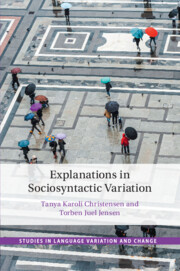Book contents
- Explanations in Sociosyntactic Variation
- Studies in Language Variation and Change
- Explanations in Sociosyntactic Variation
- Copyright page
- Contents
- Figures
- Tables
- Contributors
- Series Editor’s Preface
- Acknowledgements
- Introduction: Analysing and Explaining Syntactic Variation
- 1 Comparing Syntactic Variables
- 2 Mapping Syntax and the Sociolinguistic Monitor
- 3 A Columbia School Perspective on Explanation in Morphosyntactic Variation
- 4 On the Inevitability of Social Meaning and Ideology in Accounts of Syntactic Change: Evidence from Pronoun Competition in Netherlandic Dutch
- 5 The Predictability of Social Stratification of Syntactic Variants
- 6 When Variants Lack Semantic Equivalence: Adverbial Subclause Word Order
- Index
- References
5 - The Predictability of Social Stratification of Syntactic Variants
Published online by Cambridge University Press: 06 January 2022
- Explanations in Sociosyntactic Variation
- Studies in Language Variation and Change
- Explanations in Sociosyntactic Variation
- Copyright page
- Contents
- Figures
- Tables
- Contributors
- Series Editor’s Preface
- Acknowledgements
- Introduction: Analysing and Explaining Syntactic Variation
- 1 Comparing Syntactic Variables
- 2 Mapping Syntax and the Sociolinguistic Monitor
- 3 A Columbia School Perspective on Explanation in Morphosyntactic Variation
- 4 On the Inevitability of Social Meaning and Ideology in Accounts of Syntactic Change: Evidence from Pronoun Competition in Netherlandic Dutch
- 5 The Predictability of Social Stratification of Syntactic Variants
- 6 When Variants Lack Semantic Equivalence: Adverbial Subclause Word Order
- Index
- References
Summary
This chapter is an enquiry into whether we can predict whether a particular instance of variation at the syntactic level may reflect social stratification or not (Labov 1966, 1972, 1994). Therefore, a range of syntactic variables in Dutch has been examined that may reveal social correlations in the spontaneous speech of 67 speakers who were born, grew up, and still live in one particular locality. Most of the syntactic variables consist of variants associated with the local dialect and (codified) standard Dutch. The syntactic variables examined differ in frequency of occurrence, synonymy/functional equivalence, abstract properties, and presumably noticeability. The fact that the social stratification of various syntactic variables can be investigated by following the same speakers within one speech style, i.e. the sociolinguistic interview,L12 offers a unique opportunity to carefully discriminate the effects of similar socio-demographic factors on different types of syntactic variables. The overall result is that social stratification of syntactic variation can be predicted where syntax maps onto discourse. The outcome is dependent on the extent of duration of language contact situations, and interactions in which particular linguistic variables have become socially meaningful depending on the individual and the wider societal, political and ideological context.
Keywords
Information
- Type
- Chapter
- Information
- Explanations in Sociosyntactic Variation , pp. 144 - 170Publisher: Cambridge University PressPrint publication year: 2022
References
Accessibility standard: Unknown
Why this information is here
This section outlines the accessibility features of this content - including support for screen readers, full keyboard navigation and high-contrast display options. This may not be relevant for you.Accessibility Information
- 1
- Cited by
